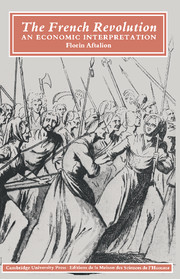Book contents
- Frontmatter
- Contents
- List of figures
- Chronology
- Acknowledgements
- Introduction
- 1 The fiscal crisis
- 2 The French economy at the end of the ‘Ancien Régime’
- 3 1789
- 4 The ‘assignats’
- 5 The finances of the Constituent Assembly
- 6 The rising cost of living, anarchy and war
- 7 The seizure of power by the Mountain
- 8 Economic dictatorship
- 9 ‘Dirigisme’ in retreat
- 10 The French Revolution: economic considerations
- Appendices
- I The final budget of the Ancien Régime
- II The grain trade
- III The life of Dupont de Nemours
- IV The value of the bids made for biens nationaux
- V Econometric study of the depreciation of the assignats
- Notes
- Select guide to further reading
- Index
V - Econometric study of the depreciation of the assignats
Published online by Cambridge University Press: 05 June 2012
- Frontmatter
- Contents
- List of figures
- Chronology
- Acknowledgements
- Introduction
- 1 The fiscal crisis
- 2 The French economy at the end of the ‘Ancien Régime’
- 3 1789
- 4 The ‘assignats’
- 5 The finances of the Constituent Assembly
- 6 The rising cost of living, anarchy and war
- 7 The seizure of power by the Mountain
- 8 Economic dictatorship
- 9 ‘Dirigisme’ in retreat
- 10 The French Revolution: economic considerations
- Appendices
- I The final budget of the Ancien Régime
- II The grain trade
- III The life of Dupont de Nemours
- IV The value of the bids made for biens nationaux
- V Econometric study of the depreciation of the assignats
- Notes
- Select guide to further reading
- Index
Summary
In my attempt to account for the depreciation of the assignats, I have had recourse to a simple econometric technique. It consists in positing a demand function of money and then testing it (by means of a linear regression) on the revolutionary paper. Additional problems peculiar to the assignats, some of a theoretical nature, others arising out of the data available to us, further complicate an otherwise classical test.
Theoretical problems
It is traditional to posit that economic agents desire to hold cash in order to make transactions. The real quantity of currency required for this purpose (independent of variations in price) is therefore proportional to the volume of exchanges occurring in the economy, i.e. to production. Since, in a relatively primitive situation such as that of the French economy at the end of the eighteenth century, the holding of currency for the purposes of financial speculation must have been minimal, I shall disregard the effect of interest rates (which are anyway unknown to us). On the other hand, forecasts of the rate at which depreciation accelerated may have played an important role, especially after the beginning of 1795. As I have no way of assessing such forecasts, I will bring this study to a close at June 1795, the date at which they probably became a crucial factor.
Coin did not disappear all of a sudden from transactions. During a period whose duration cannot be specified, coins and paper money were used simultaneously, the public's total demand for money then including both of these two means of payment.
- Type
- Chapter
- Information
- The French RevolutionAn Economic Interpretation, pp. 206 - 207Publisher: Cambridge University PressPrint publication year: 1990



